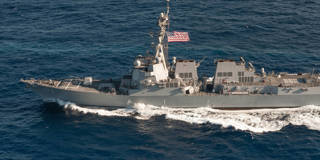STEPHEN S. ROACH

NEW HAVEN – Too many observers have lost sight of one of the key lessons of World War I. The Great War was triggered by the assassination of Austrian Archduke Franz Ferdinand in June 1914, which occurred against the backdrop of a long-simmering conflict between Europe’s major powers. This interplay between conflict escalation and a political spark has special resonance today.
With war raging in Ukraine and a cold-war mentality gripping the United States and China, there can be no mistaking the historical parallels. The world is simmering with conflict and resentment. All that is missing is a triggering event. With tensions in Taiwan, the South China Sea, and Ukraine, there are plenty of possible sparks to worry about.
Taiwan is a leading candidate. Even if, like me, you do not accept the US view that President Xi Jinping has consciously shortened the timeline for reunification, recent actions by the US government may end up forcing his hand. Former House Speaker Nancy Pelosi traveled to Taipei last August, and her successor, Kevin McCarthy, seems intent on doing the same. The newly established House Select Committee on China appears likely to send its own mission shortly, especially following the unannounced recent visit of its chairman, Mike Gallagher.
Meanwhile, a just-completed visit to Taipei by a senior official from the Pentagon, in the aftermath of the December enactment of the $10 billion Taiwan Enhanced Resilience Act, leaves little doubt about US military support for China’s so-called renegade province. While the US squirms to defend the One China principle enshrined in the 1972 Shanghai Communiqué, there can no longer be any doubt about US political support for preserving Taiwan’s independent status. That is a red line for China – and a geopolitical flashpoint for everyone else.
I worry just as much about a spark in Ukraine. One year into this horrific and once-unthinkable conflict, there is a new and ominous twist to Russian President Vladimir Putin’s spring offensive. The US is warning of an escalation of Chinese support for Russia from non-lethal assistance (like purchasing Russian energy products) to lethal aid (weapons, ammunition, or logistical arms-supply capabilities).
The Biden administration’s vague threat of serious consequences for China if it offers lethal aid to Russia’s war effort is reminiscent of similar US warnings that preceded the imposition of unprecedented sanctions on Russia. In the eyes of US politicians, China would be guilty by association and forced to pay a very steep price. Just as Taiwan is China’s red line, Washington believes the same can be said of Chinese military support for Russia’s war campaign.
There are plenty of other potential sparks, not least from ongoing tensions in the South China Sea. The recent expansion of US access to Philippine military bases located midway between Taiwan and China’s militarized islands in the Scarborough Shoal and the Spratly (Nansha) Archipelago is a case in point.
As the US continues to enforce freedom of navigation in the international waters of the South China Sea by sailing naval vessels through it, the possibility of an accident or unintended confrontation can hardly be ruled out. A near-miss between a US reconnaissance flight and a Chinese warplane in late December is indicative of these risks, which are all the more serious given the breakdown in military-to-military communications between the two superpowers – glaringly evident during the great balloon fiasco earlier this month.
Context is key in assessing the likelihood of any spark. Under the political cover of what it bills as a battle between autocracy and democracy, the US has clearly been the aggressor in turning up the heat on Taiwan over the past six months. Similarly, the Chinese surveillance balloon incident brought the cold-war threat much closer to home for the US public. And senior diplomats on both sides – US Secretary of State Antony Blinken and his Chinese counterpart, Wang Yi – have taken on the role of classic Cold Warriors. Their belligerent rhetoric at the recent Munich Security Conference mirrored that of their first meeting in Anchorage nearly two years ago.
As was the case before World War I, it is tempting to minimize the risk of a major conflict. After all, today’s globalized, interconnected world has too much at stake to risk a seismic unraveling. That argument is painfully familiar. It is the same one made in the early twentieth century, when the first wave of globalization was at its peak. It seemed compelling to many right up to June 28, 1914.
The historical comparison with 2023 must be updated to reflect the grand strategy of cold war conflict. A decisive turning point in the Cold War with the Soviet Union came in 1972, when US President Richard Nixon went to China and ultimately joined with Mao Zedong in executing a successful triangulation strategy against the USSR. Today, the US is on the receiving end of a new cold-war triangulation, with China having joined Russia in a partnership “without limits” that takes dead aim at US hegemonic power. This pivotal shift brings the lessons of 1914 into increasingly sharper focus.
Having just published a book about accidental conflict as an outgrowth of dueling false narratives between the US and China, I am particularly worried about “narrative segmentation.” Each side is convinced that it holds the moral high ground as conflict lurches from one incident to another. For the US, China’s surveillance balloon was a threat to national sovereignty. For China, US support for Taiwan is a similar threat. Each point of tension then triggers a cascading stream of retaliatory responses without recognition of collateral implications for a deeply conflicted relationship.
Three great powers – America, China, and Russia – all seem to be afflicted by a profound sense of historical amnesia. They are collectively sleepwalking down a path of conflict escalation, carrying high-octane fuel that could be ignited all too easily. Just like 1914.
No comments:
Post a Comment